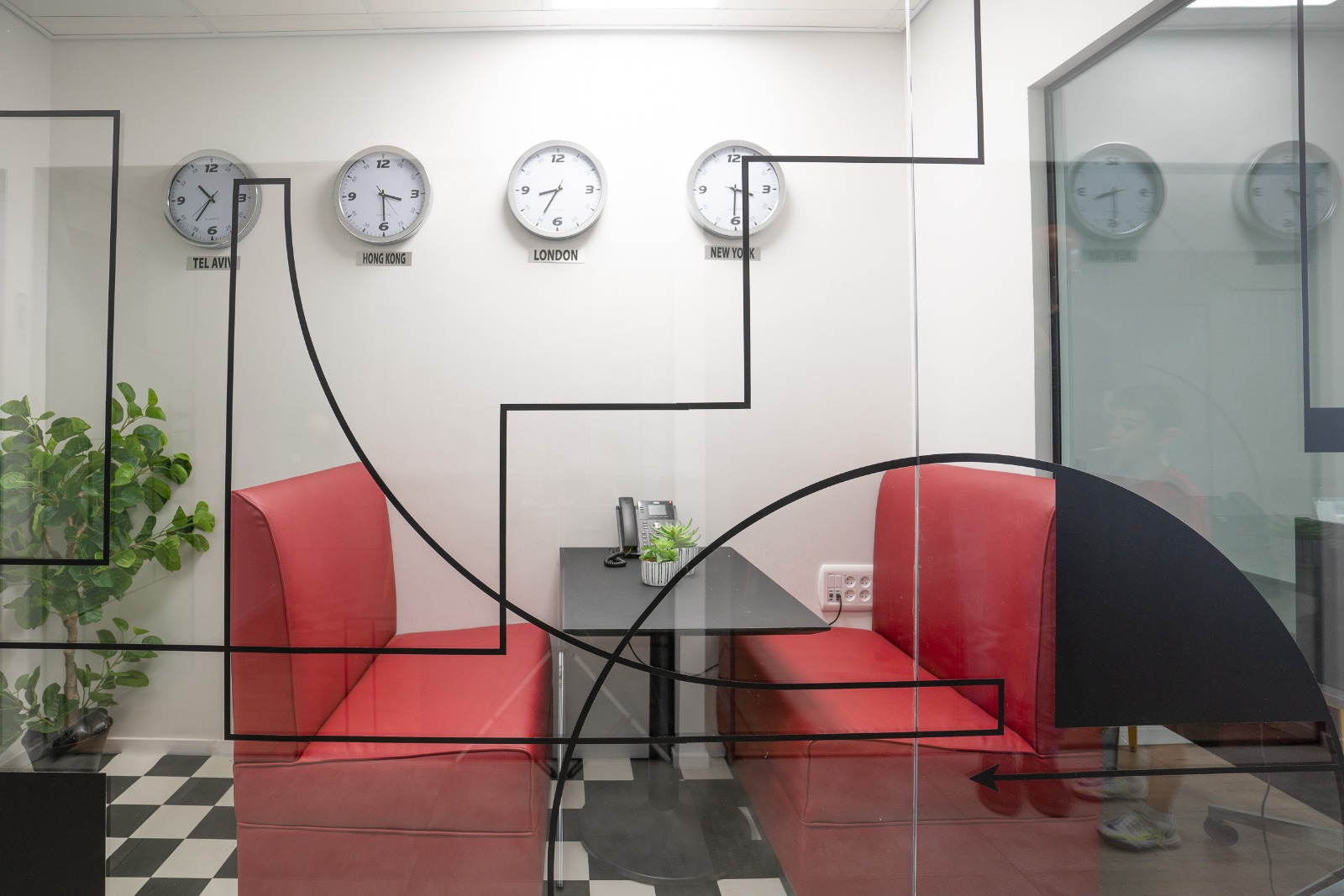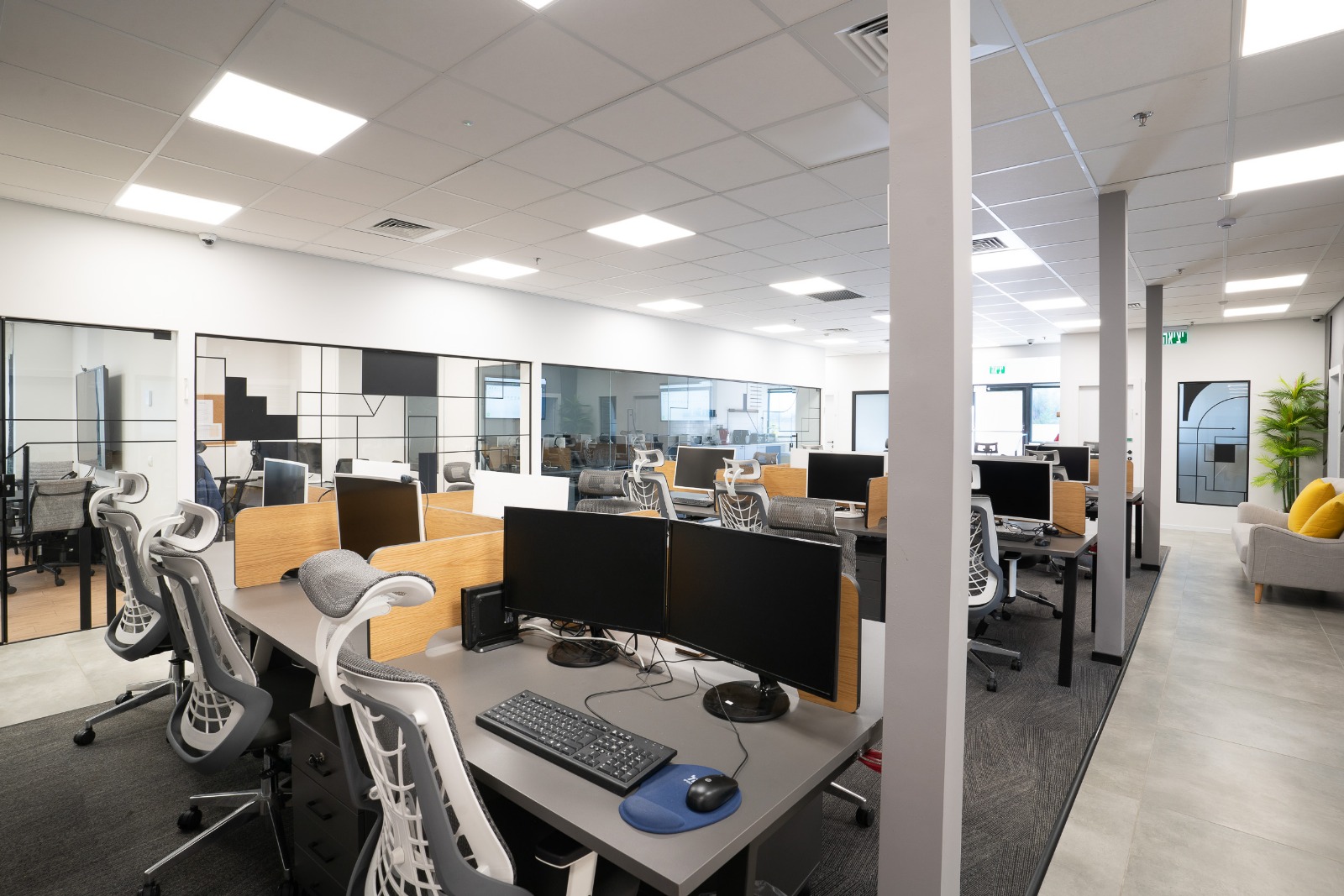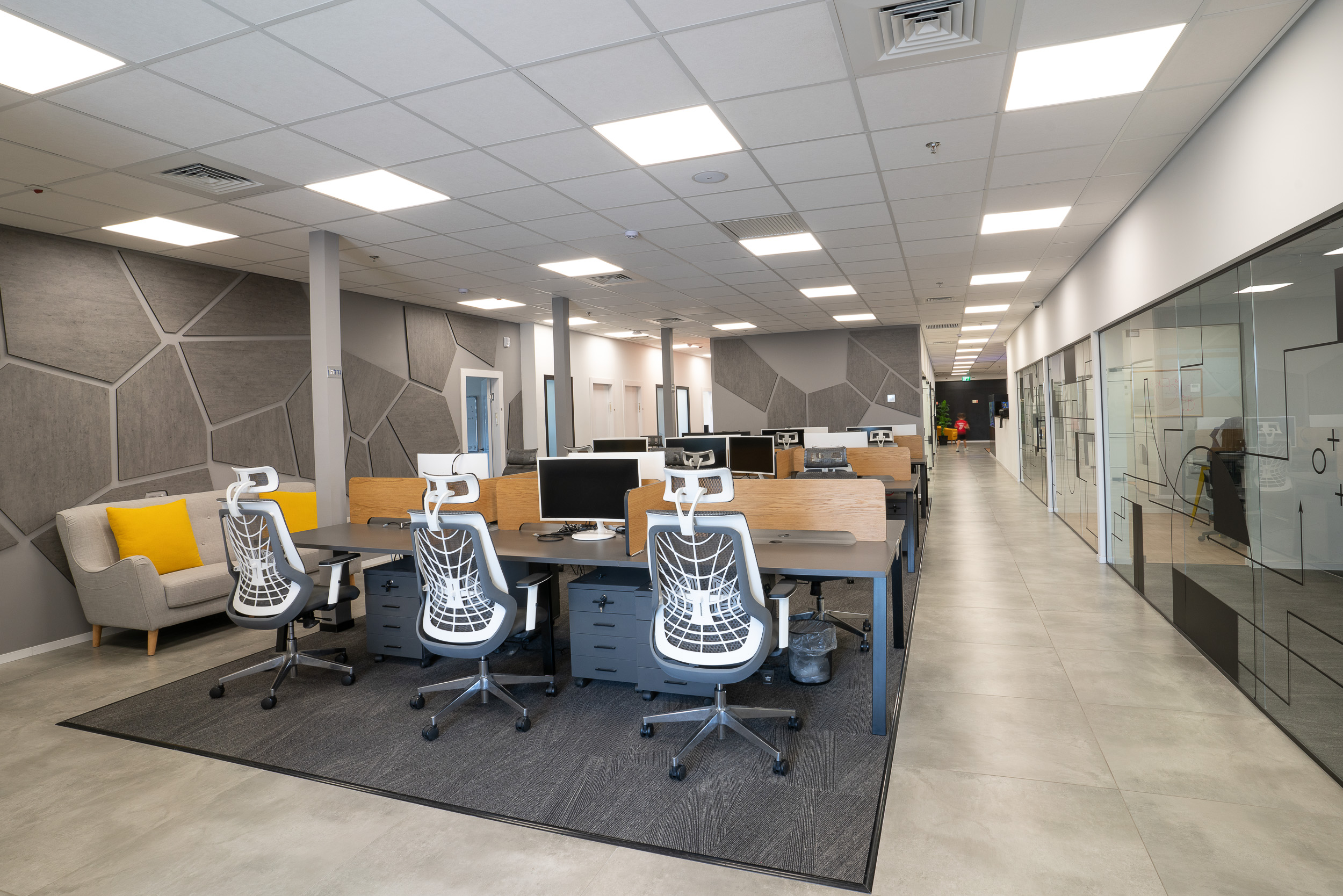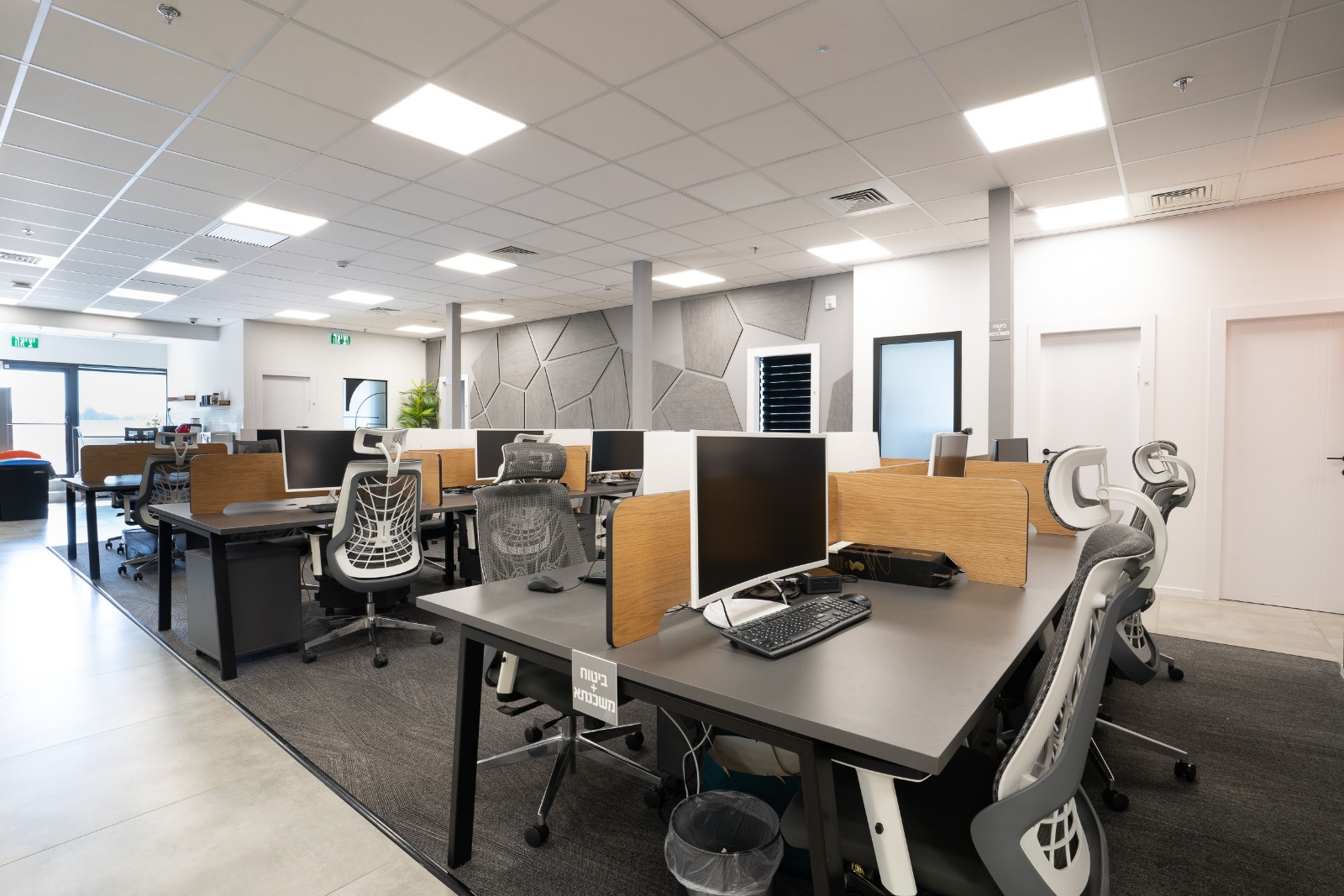What Is Hybrid Office Design?
Hybrid office design is an innovative approach that adapts the work environment to today’s reality, where employees are not required to be in the office every day of the week. Instead, they come in only part of the time – for example, two or three days – while the rest of the time they work from home or any other location.
This shift began during the COVID-19 pandemic, which accelerated the move toward flexible work models and reduced the need for large office spaces. The trend quickly gained momentum worldwide, leading to a new way of thinking about office design – not only as a physical infrastructure for work, but as a space with a direct impact on organizational identity, employee loyalty, and operational efficiency.
Key Advantages and Features of Hybrid Offices:
Flexibility – employees choose when and where to work, balancing personal needs with team requirements.
Blending physical and digital presence – face-to-face meetings for coordination and collaboration alongside independent remote work.
Time and cost savings – less need for large office spaces and fewer commutes.
Adaptive spaces – instead of fixed desks for all, offices feature shared areas, flexible workstations, meeting zones, and Zoom rooms.

A Designed Meeting Corner for the Hybrid Office
In a flexible and dynamic office, it is essential to create spaces that combine privacy, comfort, and smart design. The seating corner shown in the picture is located in a closed yet transparent space, offering a spot for meetings, conversations, or quiet phone calls without distractions. The cushioned benches and symmetrical layout create a sense of intimacy, while the glass walls and graphic design elements maintain openness and visual flow. The world clocks on the wall connect the space to global activity, and the built-in charging station provides a practical solution for employees. This design demonstrates that a hybrid office doesn’t have to be just about workstations – but rather a smart blend of diverse spaces that serve different needs.

A Smartly Designed Hybrid Office
An open workspace that combines personal privacy with a collaborative team environment. Each workstation is tailored to the employee, with partitions that provide a sense of focus and individuality. Acoustics are handled on multiple levels: noise-absorbing carpets, acoustic wooden wall panels, and carefully planned workstation layouts – all ensuring a quiet and pleasant work atmosphere. Electrical and communication infrastructures are hidden within columns and built-in cladding, creating a clean, aesthetic, and organized look. This hybrid office perfectly blends functionality, comfort, and design – exactly what today’s employees need.
Who Is a Hybrid Office Design For?
Hybrid office design is ideal for companies that want to preserve organizational culture, collaboration, and effectiveness – without giving up flexibility and a healthy work-life balance.
The hybrid model opens up countless opportunities for creating smart, flexible, and inspiring spaces.
The Impact of Office Design on the Hybrid Employee
Professional office design is not only an aesthetic or planning solution, but also a psychological and functional foundation for productive work. When employees come into the office, the physical environment gains symbolic meaning: it reflects the company’s values, its investment in people, and its work culture.
In a reality where employees are used to the comfort, intimacy, and control of the home environment, the office experience must offer a clear advantage – not only functional, but also emotional. Recent studies show that employees are more willing to return to the office when it provides added value: social interaction, a sense of community, professional enrichment, and an inspiring atmosphere.
All of these depend directly on proper planning and design of the workspace.
Four Key Dimensions of Hybrid Office Design
Belonging and Identity
Using a design language that embodies brand values: colors, materials, typography, and graphic elements that connect employees to the company’s vision. Every detail – from the logo at the entrance, to the lighting, design elements, and finishing materials – contributes to a coherent, branded experience.
It is equally important to integrate personal touches, such as inspiration walls, team display areas, or local art pieces, which anchor the organizational identity within a cultural context.
Comfort and Focus
Designing quiet, secluded areas alongside collaborative spaces allows cognitive flexibility. Lighting plays a critical role here: natural light improves alertness and mood, while smart artificial lighting – with dimming or personalized control – enables long hours of work without visual strain.
Acoustics, ergonomic chairs, and noise-absorbing finishes further enhance concentration and comfort.
Functional Flexibility
Modular furniture, dynamic work areas, and smart technologies allow adaptation to changing needs. Smart systems enable employees to book desks, operate meeting rooms, or connect devices intuitively. Mobile furniture, movable partitions, and height-adjustable desks provide solutions for diverse work styles.
Community and Social Hubs
Kitchenettes, lounges, brainstorming zones, and similar areas create an experience of belonging, not just task execution. These spaces are designed to encourage team interaction and strengthen interpersonal connections. Living plants add calmness and bring nature indoors. Shared benches, inviting counters, and cozy coffee corners foster warmth and reduce the sense of impersonality often found in open-plan offices.
The Hybrid Space – Neither Home nor Office, but Both
One of the common mistakes is to think office design is meant only to “bring employees back to the office.” In reality, the challenge is to create a space where employees don’t feel forced, but choose to come.
A true hybrid environment is not a replica of the home office – but a smart blend of home-like autonomy and the organizational dynamics of the workplace.
In this sense, office design becomes part of a broader strategic framework – an infrastructure for managing hybrid employees, creating a flexible organizational culture, and maintaining a sense of connection even when work happens remotely.
The office is not merely a workstation, but a community hub. With proper planning, it enables formal meetings as well as informal interactions, using open spaces, natural light, natural materials, and integrated remote communication technologies as an essential part of the experience.

Modern Workstations in a Hybrid Office
A spacious open workspace featuring shared workstations, a geometric decorative wall, and lounge sofas – all designed to support a dynamic and flexible hybrid work environment.

Open Space Work Environment
A clean, modern office design with well-arranged workstations, soft lighting, and improved acoustics – perfectly suited for the hybrid work model.
Branding Through Design – A Space That Tells the Organizational Story
In an era where organizational culture is physically dispersed, the office becomes the place to consolidate and strengthen a shared identity. It is not only a workspace but also a living stage for the company’s values and spirit. Office design is a powerful branding tool, shaping how the organization is perceived by employees, clients, suppliers, and investors.
When the space reflects the company’s DNA, the result is an inspiring experience: a reception area that communicates the message from the very first moment, bold or subtle colors aligned with the organization’s character, and a sense of trust and innovation that embodies its core values. Every detail – from the shape of door handles to the framing of artworks – is an opportunity to deliver a clear, consistent, and distinctive message.
Properly branded office design contributes to reputation through a strong visual identity, an unforgettable visitor experience, and a design statement that lingers long after the first meeting. It builds trust, differentiates the company in a competitive market, and more.
Three Approaches to Hybrid Office Design
The Modular Approach
Designing spaces that can easily adapt to changing needs: mobile desks, foldable partitions, seating areas that can be converted into meeting rooms, and lounges that transform into workshop spaces. This approach suits dynamic companies where teams change frequently. The main benefit: operational flexibility and quick adaptability.
The Resimercial Approach
Incorporating design elements inspired by the home: soft furniture, warm fabrics, designer lighting, bookshelves, houseplants, and relaxation zones. The goal is to provide a sense of comfort and intimacy, reduce stress, and ease the transition from home to office. This approach strengthens the feeling of belonging and well-being.
The Technological-Connective Approach
Designing the workspace as a technological hub: meeting rooms with smart video systems, workstations adapted for relocation employees, and integration of apps for space and equipment management. This approach is relevant for global companies or geographically distributed teams that rely on remote connectivity. The key advantage: functional continuity even when employees work from different locations.
Hybrid Office Design – Turning Challenges Into Opportunities
Hybrid office design takes a potentially challenging situation (such as employees needing to stay home for safety) and creatively transforms it into a new reality for many companies. Those who invest in adapting their offices to this model are likely to gain stronger employee loyalty.
For more tailored insights, we recommend scheduling a free initial consultation with our design team.
